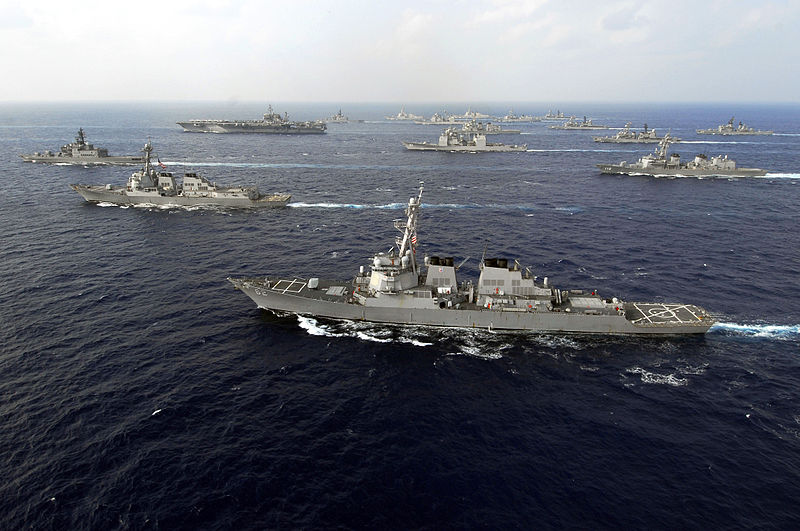 The strategy behind China’s emerging naval capability is subject to considerable debate. Most of the commentary concentrates on the People’s Liberation Army Navy’s (PLAN) capability development. Some commentators argue that the PLAN has shifted its focus towards developing a ‘blue water navy’ to contest America’s maritime predominance in the Western Pacific. But, as David McDonough’s recent post on The Strategist points out, the PLAN also continues to invest in defensive ‘anti-access/area-denial’ (A2/AD) for operations in its ‘ First Island Chain’. The common theme of these assessments is that China’s growing naval power should have us worrying.
The strategy behind China’s emerging naval capability is subject to considerable debate. Most of the commentary concentrates on the People’s Liberation Army Navy’s (PLAN) capability development. Some commentators argue that the PLAN has shifted its focus towards developing a ‘blue water navy’ to contest America’s maritime predominance in the Western Pacific. But, as David McDonough’s recent post on The Strategist points out, the PLAN also continues to invest in defensive ‘anti-access/area-denial’ (A2/AD) for operations in its ‘ First Island Chain’. The common theme of these assessments is that China’s growing naval power should have us worrying.
However, while the PLAN’s growing maritime capabilities potentially pose a challenge to the United States and countries in the Indo-Pacific region, it’s also important to consider the weaknesses in China’s maritime strategy. Indeed, I’d argue that provided the US and its allies and partners invest in smart counter-strategies, China will find it very difficult to overcome its maritime dilemmas and to coerce regional countries in accepting Beijing’s territorial claims.
Let’s start with China’s ‘Taiwan Dilemma’. The conventional wisdom is that China has already ‘succeeded’ in its A2/AD strategy in the Taiwan Straits by raising the costs for third-party intervention prohibitively high, i.e. keeping US carrier battle groups at arms length. But even if the PLA manages to keep US forces out of a conflict through a ‘sea denial strategy’—which in itself is a very risky assumption given the importance of Taiwan in US Pacific strategy—it faces serious political and operational challenges in invading Taiwan. As I’ve argued elsewhere, Taiwan is systematically investing in its own ‘sea denial strategy’ and the PLA would need to physically destroy most of the island’s infrastructure prior to invasion, with disastrous consequences for China’s international and regional reputation. In short, the PLAN’s A2/AD approach in the Taiwan Straits might not translate into real political currency for Beijing’s leadership.
Secondly, US naval strategists argue that the PLAN faces a ‘strategic chokepoint dilemma’. The moment the PLAN sails through the Taiwan Straits into the wider Western Pacific Ocean, it faces the combined naval power of the US Navy and her allies, particularly Japan. It couldn’t hope to establish a significant level of ‘sea control’ in this area. Moreover, as soon as the PLAN projects maritime power out of Hainan Island into the South China Sea to assert its claims in the ‘nine-dashed line’ it will face a reengaged US military as well as A2/AD ‘pockets’ of Southeast Asian countries. Just like the US Navy and other modern navies, the PLAN won’t be immune from sea denial capabilities such as submarines, anti-submarine warfare and anti-ship missiles. Moreover, the Chinese Government has pointed to the country’s ‘Malacca Dilemma’—the PLAN’s inability to protect China’s energy transport in this strategic chokepoint. But given the geostrategic characteristics of the Malacca Strait—only 1.5 nm at its narrowest point and critical not just for China but the rest of Asia—military options for China are also very limited. Any attempt to project naval power to control this area will automatically draw China into conflict with regional heavyweights such as India, Indonesia and Japan—hardly a winning formula.
Finally, Chinese strategists seem to be aware that the offensive use of naval power against its Asian neighbours will most likely not achieve any political objective; the opportunity costs of a war at sea are just too high. That’s probably why the most significant recent development in China’s maritime strategy has been the creation of a unified coast guard agency. This step potentially strengthens China’s capacity to use non-military vessels for coercive purposes in territorial disputes with Japan and Southeast Asian nations.
But even this strategy has limits. Regional countries are upgrading their coast guards and other maritime agencies to level the playing field. They also cooperate, as in the case of Japan and The Philippines. In July, Tokyo announced it would provide Manila with 10 coast guard patrol boats through a yen loan to help it to counter Beijing’s maritime assertiveness. Regional countries are also increasing their maritime surveillance capabilities to monitor and expose Chinese maritime behaviour to a domestic, regional and global audience. This fundamentally undermines Beijing’s attempt to restore its ‘soft power deficit’ accumulated over recent years.
While China’s naval power projection will certainly grow in the future, it’s far from inevitable that the PLAN’s coercive potential will increase commensurately. Indeed, the PLAN’s current desire for big surface combatants and aircraft carriers runs counter to modern navies’ recognition that the future lies in a greater number of smaller, more dispersed and less vulnerable ships which operate as part of a joint force. I’m not yet convinced that China as a continental power has much to gain politically by investing in a very expansive, offensive blue water navy. And even if it does, the good news is that there’ll be lots of ways to offset the PLAN strategy.
Benjamin Schreer is a senior analyst at ASPI. Image courtesy of Wikimedia Commons.

